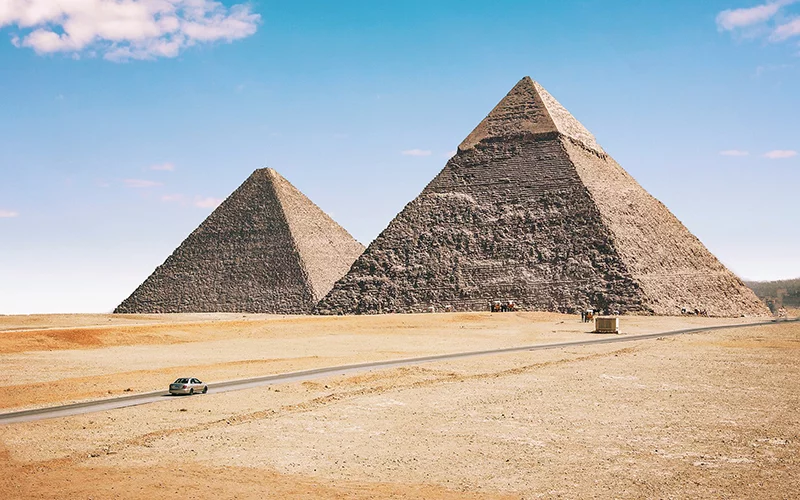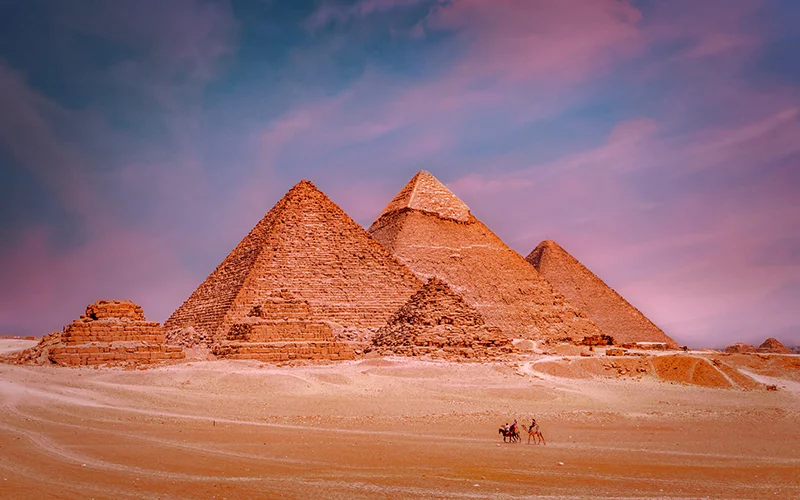The Great Pyramid of Giza (Cheops Pyramid) is the oldest and largest of the three monumental pyramids located in the ancient city of Giza, which surrounds the Giza region of Egypt 's capital, Cairo. The Great Pyramid of Giza in the list of the seven wonders of the ancient world; It is also known as the Pyramid of Cheops, the Pyramid of Khufu or the Great Pyramid . The monumental complex, which is estimated to have been built between 2 thousand 551 BC and 2 thousand 560 BC, is the only work of the seven wonders of the world that has survived to the present day.
The building, which is thought to have been built as a monumental tomb for the Egyptian Pharaoh Khufu, was considered the largest man-made structure in the world with its volume and mass until the beginning of the 20th century. There are different assumptions about the technique used to build the pyramid, whose exterior was covered with stone slabs in its original structure. The Great Pyramid of Giza continues to exist as a giant artifact that has not yet been fully understood.
Great Pyramid of Giza, Cairo
The magnificence and size of the Great Pyramid of Giza is difficult to put into words. The pyramids still preserve their mystery about their construction and history. The Great Pyramid of Giza is among the best-known structures not only in Egypt, but also in the world. The Great Pyramid of Giza is located in the Giza region of Cairo, the capital of Egypt.
Giza is also known as the necropolis area of Memphis, the capital of the old imperial period. The Great Pyramid of Giza was built by the Egyptian Pharaoh Khufu between 2 thousand 551 BC and 2 thousand 560 BC as a tomb for him after he died.
Contrary to popular belief, only the Great Pyramid of Giza is on the list of the Seven Wonders of the World, not the three pyramids at Giza. Although the history of the Great Pyramid of Giza is not known exactly and its mystery is still unsolved, it is thought that the pyramid was completed in a period of 20 years.
After the ground was brought to a suitable condition at first, the stone blocks were moved and took the form of a pyramid over time. It is not known how the stone blocks, each weighing two tons, were transported. According to one theory, the stone blocks were stacked on top of each other via a mud-covered spiral ramp. According to another theory, levers were used to lift the giant stone blocks.
In the museum in Giza, where other pyramids are also located, the ship called Khufu Ship or Sun Ship, whose existence was discovered in 1954, can be seen. It is believed that this ship carried Pharaoh Khufu over the Nile to the pyramid after his death and sent him off on his final journey.
Information about the Great Pyramid of Giza

It is estimated that the Great Pyramid of Giza was 145 meters long at the time it was built. The pyramid, which decreased by 10 meters from its height over time, did not compromise on its splendor. The pyramid remained the largest structure on earth until the 19th century.
Another striking feature of the pyramid is that although it was completed in as little as 20 years, it consists of 2 million stone blocks, each weighing two tons. The information that a wall long enough to frame the entire French border could be created with the stones of the three pyramids in Giza gives a clue about the size of the structure.
The entrance to the Great Pyramid of Giza is located in the north-facing part of the pyramid. After the entrance, there are many corridors and rooms leading to the tomb of the Pharaoh, but there is no clear information about what purpose they served.
Throughout history, new theories have been put forward regarding the reason for the existence of the Giza Pyramids. There are many beliefs from the pyramids serving astronomical observations to being used as temples. However, historical and scientific evidence points to the fact that the pyramids were built as monuments to carry the great rulers of the time to the present day.
Thanks to the pyramids, great pharaohs such as Khufu, Khefre and Menkaure passed their afterlife in these magnificent structures in the region west of the Nile and managed to make their names known thousands of years later.
Parts of the Great Pyramid of Giza

Great Pyramid of Giza; It consists of entrance, descent and exit corridors, the king's room, the queen's room and a large gallery.
Entrance, descent and exit corridors : It is possible to descend into the landing corridor of the Great Pyramid of Giza, but visitors are not allowed to enter. With the decision taken in the past years, photography in the landing corridor was also strictly prohibited.
After 345 steps in the entrance hall, which continues downwards as a corridor after the original entrance of the pyramid, the slope on the ground disappears and becomes flat. Reaching the room below, this corridor continues horizontally on the south wall of the room below.
Egyptologists accept the assumption that the room below was designed as the place where Pharaoh Khufu wanted to be buried, but later changed his mind and wanted to be buried higher. Some scientists, on the other hand, state that the room, which was prepared in case the Pharaoh died early, became dysfunctional after the pharaoh did not die, and that a second room (queen room) was prepared 5 years later.
After the queen's room could not be completed, approximately 15 years later, the king's room was built higher up and in the center of the pyramid.
Queen's Room : There are two channels called ventilation ducts on the north and south walls of the Queen's Room . Discovered in 1872 by the excavations of British engineer Waynman Dixon, the Queen's Chamber still remains a mystery since its construction was left unfinished.
The Great Gallery : The Great Gallery is located in the continuation of the Exit Hallway. At the upper end of the Great Gallery, near the roof on the right, is an opening that leads into a short tunnel. This opening provides access to the lowest chamber above the king's chamber.
There is also a staircase on the sloping floor of the Great Gallery. On the walls of the gallery, 54 horizontal and vertical nests, 27 on the right and 27 on the left, were discovered, the purpose of which is unknown. It is estimated that the slots were once a granite door.
The King's Chamber : The King's Chamber is considered an engineering masterpiece built according to the golden ratio. Called the genius of Egyptian geometry, the King's Room has a flat ceiling with a duct entrance called a ventilation duct.
Contrary to their names, ventilation channels do not contribute to the ventilation of the pyramid. Scientists think that these channels were built for celestial bodies. The chambers located above the King's Chamber, carved with 9 large flat granite stones reaching a total of 400 tons, arouse admiration with their appearance.

Great Pyramid of Giza entrance fee and visit information



The Great Pyramid of Giza is the only artifact of the 7 wonders of the ancient world that has survived to the present day. Despite all the research and investigations, the Cheops Pyramid, which still manages to preserve its mystery, is also Egypt's most important tourist attraction.
